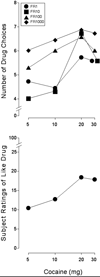Alternative reinforcer response cost impacts cocaine choice in humans
- PMID: 22015480
- PMCID: PMC3229673
- DOI: 10.1016/j.pnpbp.2011.10.003
Alternative reinforcer response cost impacts cocaine choice in humans
Abstract
Cocaine use disorders are an unrelenting public health concern. Behavioral treatments reduce cocaine use by providing non-drug alternative reinforcers. The purpose of this human laboratory experiment was to determine how response cost for non-drug alternative reinforcers influenced cocaine choice. Seven cocaine-using, non-treatment-seeking subjects completed a crossover, double-blind protocol in which they first sampled doses of intranasal cocaine (5, 10, 20 or 30 mg) and completed a battery of subject-rated and physiological measures. Subjects then made eight discrete choices between the sampled dose and an alternative reinforcer (US$0.25). The response cost to earn a cocaine dose was always a fixed ratio (FR) of 100 responses. The response cost for the alternative reinforcer varied across sessions (FR1, FR10, FR100, FR1000). Dose-related increases were observed for cocaine choice. Subjects made fewer drug choices when the FR requirements for the alternative reinforcers were lower than that for drug relative to when the FR requirements were equal to or higher than that for drug. Intranasal cocaine also produced prototypical stimulant-like subject-rated and physiological effects (e.g., increased ratings of Like Drug; elevated blood pressure). These data demonstrate that making alternative reinforcers easier to earn reduces cocaine self-administration, which has implications for treatment efforts.
Copyright © 2011 Elsevier Inc. All rights reserved.
Conflict of interest statement
The authors declare no conflicts of interest relevant to this work.
Figures

Similar articles
-
Alternative reinforcer response cost impacts methamphetamine choice in humans.Pharmacol Biochem Behav. 2013 Jan;103(3):481-6. doi: 10.1016/j.pbb.2012.09.025. Epub 2012 Oct 6. Pharmacol Biochem Behav. 2013. PMID: 23046851 Free PMC article. Clinical Trial.
-
Intranasal cocaine functions as reinforcer on a progressive ratio schedule in humans.Eur J Pharmacol. 2010 Oct 10;644(1-3):101-5. doi: 10.1016/j.ejphar.2010.06.055. Epub 2010 Jul 16. Eur J Pharmacol. 2010. PMID: 20638380 Free PMC article. Clinical Trial.
-
Influence of acute bupropion pre-treatment on the effects of intranasal cocaine.Addiction. 2012 Jun;107(6):1140-7. doi: 10.1111/j.1360-0443.2011.03766.x. Epub 2012 Feb 11. Addiction. 2012. PMID: 22168398 Free PMC article. Clinical Trial.
-
Choice between variable and fixed cocaine injections in male rhesus monkeys.Psychopharmacology (Berl). 2017 Aug;234(15):2353-2364. doi: 10.1007/s00213-017-4659-9. Epub 2017 Jun 10. Psychopharmacology (Berl). 2017. PMID: 28601964 Free PMC article.
-
A labor-supply analysis of cocaine self-administration under progressive-ratio schedules: antecedents, methodologies, and perspectives.Psychopharmacology (Berl). 2000 Dec;153(1):1-16. doi: 10.1007/s002130000610. Psychopharmacology (Berl). 2000. PMID: 11255919 Review.
Cited by
-
Relative expected value of drugs versus competing rewards underpins vulnerability to and recovery from addiction.Behav Brain Res. 2020 Sep 15;394:112815. doi: 10.1016/j.bbr.2020.112815. Epub 2020 Jul 22. Behav Brain Res. 2020. PMID: 32707138 Free PMC article. Review.
-
Unpredictability as a modulator of drug self-administration: Relevance for substance-use disorders.Behav Processes. 2020 Sep;178:104156. doi: 10.1016/j.beproc.2020.104156. Epub 2020 Jun 8. Behav Processes. 2020. PMID: 32526314 Free PMC article. Review.
-
Modafinil decreases cocaine choice in human cocaine smokers only when the response requirement and the alternative reinforcer magnitude are large.Pharmacol Biochem Behav. 2016 Nov-Dec;150-151:8-13. doi: 10.1016/j.pbb.2016.08.009. Epub 2016 Sep 1. Pharmacol Biochem Behav. 2016. PMID: 27592732 Free PMC article.
-
Influence of phendimetrazine maintenance on the reinforcing, subjective, performance, and physiological effects of intranasal cocaine.Psychopharmacology (Berl). 2019 Sep;236(9):2569-2577. doi: 10.1007/s00213-019-05227-x. Epub 2019 Mar 21. Psychopharmacology (Berl). 2019. PMID: 30900008 Free PMC article. Clinical Trial.
-
Contextual and psychosocial factors influencing drug reward in humans: The importance of non-drug reinforcement.Pharmacol Biochem Behav. 2024 Aug;241:173802. doi: 10.1016/j.pbb.2024.173802. Epub 2024 Jun 10. Pharmacol Biochem Behav. 2024. PMID: 38866372 Free PMC article. Review.
References
-
- Donny EC, Bigelow GE, Walsh SL. Assessing the initiation of cocaine self administration in humans during abstinence: Effects of dose, alternative reinforcement and priming. Psychopharmacology (Berl) 2004;172:316–323. - PubMed
-
- Foltin RW, Fischman MW, Pedroso JJ, Pearlson GD. Repeated intranasal cocaine administration: Lack of tolerance to pressor effects. Drug Alcohol Depend. 1988;22:169–177. - PubMed
-
- García-Fernández G, Secades-Villa R, García-Rodríguez O, Alvarez-López H, Sánchez-Hervás E, Fernández-Hermida JR, Fernández-Artamendi S. Individual characteristics and response to Contingency Management treatment for cocaine addiction. Psicothema. 2011;23:114–118. - PubMed
Publication types
MeSH terms
Substances
Grants and funding
LinkOut - more resources
Full Text Sources
Medical

